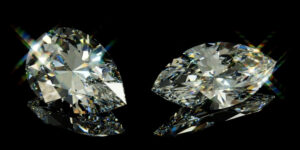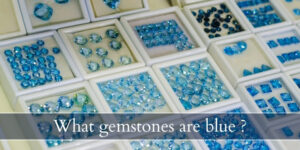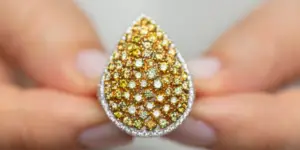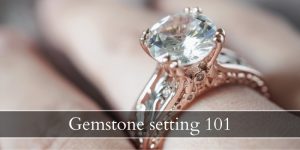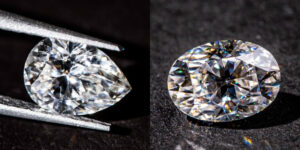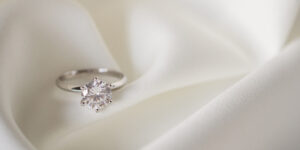Cubic zircon and zircon have been confused for the past few decades to the point where they are often synonymous. The trouble is, these two are very different, despite their similarities. And one is a knock-off of the other, or rather a synthetic version. Can you guess which ?
Let’s discuss the main differences between zircon and cubic zirconia, because there are quite a few. There are also a good amount of similarities between these two, aside from their name. So let’s take a closer look at both and then compare them.

Cubic zirconia vs zircon
Cubic zirconia is the synthetic version of zircon, and is widely used in the jewelry and costume industry. Zircon is a natural mineral and is rarely found in crystals large enough to be cut and polished for jewelry, while cubic zirconia is easily found at most jewelry stores. There is a steep price difference, with zircon being vastly more expensive compared to cubic zirconia. And finally, there are a few differences in the way the two gems play with the light, which can set them apart with ease.
Now let’s get to explaining what each of these is, so we can truly understand how and why cubic zirconia is so common.
What is zircon ? Zircon is a natural mineral that is actually common within the Earth’s crust, but in microscopic proportions. Large zircon crystals are extremely rare, and as such they are very expensive. Zircon is a zirconium silicate, and the main source of the metal zirconium. Zircon is as old as the Earth itself, and came before cubic zirconia.
What is cubic zirconia ? Cubic zirconia is a synthetic version of zircon. It is actually zirconium dioxide, and as such has slightly different properties. There have been many attempts and versions of synthetic zircon, starting with 1960s France, and then the USSR perfecting the technique in 1973. Then, in 1997 one Joseph P. Wenckus & Co actually patented the technique. It is still used to this day, both for jewelry and industrial use.
1. Cubic zirconia is man-made, zircon is natural
The ley difference between CZ and zircon is that zircon is entirely natural. It is very rare to see, as it it forms in tiny, tiny crystals that are mostly found in places where volcanoes have erupted. The crystals are tiny, yet there are ones large enough to be cut into wearable jewelry. However after WWII finding zircon that is above 1 carat is very difficult.
Cubic zirconia – otherwise known as CZ – is completely man-made, or lab grown. This allows for mass production and one of the most famous CZ producers is none other that the Swarowski company, based in Austria. Because of this, you may often find that CZ is synonymous with Swarowski crystals, or Austrian crystals. They are all the same, simply different names for cubic zirconia.
Read also: Aquamarine Engagement Ring Meaning
2. Zircon is incredibly rare as a gem, cubic zirconia is easily made
Zircon that is large enough to be cut into a gem is very rare, but CZ is very easy to find. This can be a good thing or a bad thing, depending on what you’re trying to achieve with your jewelry. If you’re looking for something unique and difficult to find, then zircon is the perfect statement piece. And it comes with a price to match.
And is you’re looking for something that is readily accessible for costume jewelry, or simply like to own a whole lot of jewelry that comes in various colors and sizes without breaking the bank, CZ is definitely a great choice. You can find cubic zirconia in all colors, all shapes, all cut styles, and any stone you can think of is probably out there waiting for you.
3. Cubic zirconia is very affordable, zircon is more expensive
There is a steep price difference between zircon and cubic zirconia. A single carat zircon of a perfect blue color can reach up to $500, with prefect clarity, heat treatment for color enhancement, and an excellent cut and polish. Lower grades can be as cheap as $60 per carat.
Meanwhile clear/white cubic zirconia can sell for as little as $12-16 per single carat, with excellent clarity and a very good cut. These really are very affordable diamond simulants.
Please remember that cubic zirconia is denser than a diamond, so it will appear slightly smaller but still be heavy as the caratage claims.
4. Zircon is usually heat treated for a bright blue color
Zircon comes in many colors by itself, but the most common version is a shade of brown. Yet the most expensive version of zircon is blue zircon, especially if it’s naturally blue. Teal and then green zircon are second and third place. There are plenty of other colors, but these are the most sought after.
Currently you will find that the blue zircon present on the market is incredibly blue and absolutely stunning. But it is heat-treated, the same way blue topaz and blue sapphires are treated to enhance their blue color. Because of this you can find a severe price difference between treated and untreated blue zircon, with the natural blue being double the price of a treated blue.
Cubic zirconia on the other hand is easily found in all color ranges, since the color can be manipulated as the crystal is cast in the crucible. This means that various elements can be added to the mix to obtain this or that color, including color-shifting versions. The prices for each color are pretty similar, and you can find nearly any color you need or like without too much hassle.
5. Cubic zirconia is not birefringent, zircon is
Each mineral or crystal has to let light travel through it. Some crystals, due to the way they form, appear to double up once light hits them. Zircon is one such crystal, and because of this high tendency for birefringence (bi- two, refringence – split) all the facets of a cut zircon will appear double.
This may sound like a good thing, like it would add more sparkle and shine. But the truth is, zircon can appear fuzzy or too ‘crowded’ when you look inside the crystal.
Cubic zircon does not have birefringence, just like a diamond. This means the image and light within the crystal does not double up or split in two. For brilliance and fire purposes, this is a better choice.
6. Zircon may fade in color when exposed to prolonged sunlight
Zircon that has been heat treated to turn brown to blue may lose a good amount of its blue color if left for several hours in direct sunlight. The resulting color is a muddy gray replacing a lot of the blue. But once you remove the zircon and place it in total darkness for at least 72 hours, most of the blue will return. It will not be as bright and beautiful as before, but it will still be a shade of blue.
For this reason we recommend you don’t wear zircon each and every day, but instead restrict it to occasional wear or evening wear only.
Cubic zirconia does not have this problem, and and be worn at any point during the day without losing its color.
Similarities between zircon and cubic zirconia
There are many differences between cubic zirconia and zircon, enough to set them apart once you stop to think about it. However there are several similarities that make telling them apart a little difficult as well. Here’s what you should be aware of, and thus not use to try and differentiate the two.
Both zircon and cubic zirconia are very dense minerals
Each and every substance on this Earth has a weight, or rather a density, how tightly packed the atoms are. Because of this, some are heavier than others. In this case both zircon nd cubic zirconia are very dense minerals, and both are much denser than a diamond. Here’s a bit of a comparison in density:
- amethyst density is 2.65 g/cm3
- diamond density is 3.5-3.53 g/cm3
- sapphire density is 3.98 g/cm3
- zircon density is 4.6-4.7 g/cm3
- cubic zirconia density is 5.6-6.0 g/cm3
So what does this mean ? The higher the density of a mineral, the heavier it is. And gemstones are measures in carats, which do not measure size in millimeters, but instead they measured in grams. This means that 1 ct of cubic zirconia will look smaller than 1 ct of zircon, and both will look smaller than 1 ct of diamond. All three will measure exactly 1 ct, which is 0.200 grams, but will take up progressively less space.
Both zircon and cubic zirconia are great diamond simulants
Zircon was THE first diamond simulant, since it’s one of the oldest gemstones discovered. And for a very long time it was used as a diamond simulant because it was the only gem that came close. Moissanite was not yet discovered and CZ was not yet invented. In fact CZ was meant to be used instead of zircon.
Both have high refractive indexes, meaning they offer very good light play once the light enters the crystals. Zircon has a refractive index of 1.92-1.96, while cubic zirconia is 2.16. Both are pretty nigh, but a diamond is 2.42, and the only thing surpassing it is moissanite at 2.65.
To put all of this into perspective, imagine an icicle, and how the sun sparkles within it. Pure ice has a refractive index of 1.30 while liquid water is 1.33. Clean glass is 1.52.
Both zircon and cubic zirconia are prone to scratches
Any gemstones you may want to wear should be considered from a practical point of view, such as how they behave in time. One way to look at this is the Mohs scale rating for each stone. This scale measures a stone’s hardness, how easily it chips and scratches. It’s on a scale of 1 to 10, and zircon scores a 7.5-8 on this scale. Cubic zirconia scores an 8. Both are above 7, and any gem above 7 is deemed for for daily wear.
That being said, this does not mean your zircon or cubic zirconia will never scratch or chip. They can accumulate scratches over time, but they won’t be as fragile as, say a pearl or opal.
For comparison, moissanite (another diamond simulant) scores a 9.25-9.5 on the same Mohs scale, and it is much more resistant to scratches and chipping. Diamonds score a perfect 10.

I’m the main author for jewelrymaterialguide.com. I started this site after we did tons of research before our wedding and noticed that there is information about rings, jewelry, and so on that is really hard to find on the internet.

